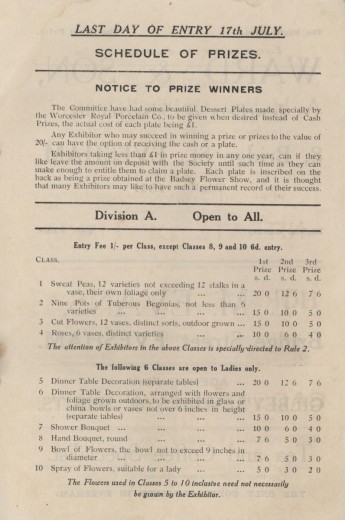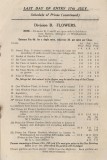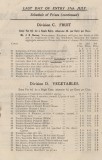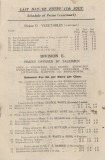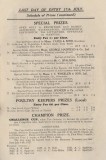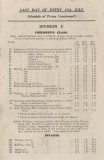
Classes and prizes
There were 105 classes in six divisions, not that dissimilar to today, though a few classes were open to ladies only. Compared with today, the cash prizes were significant, ranging from 20 shillings for 1st prize for “Sweet Peas, 12 varieties not exceeding 12 stalks in a vase, their own foliage only” and “Dinner Table Decoration (separate tables)” down to 3 shillings for 1st prize for a window plant or aspidistra. The 1st prizes for front gardens was 15 shillings and for back gardens 10 shillings. The majority of fruit and vegetable classes commanded a 1st prize of 4 shillings or 5 shillings. The champion prize was the Challenge Cup, value 10 guineas, awarded to the most successful exhibitor in the local classes.
In 1925, the Flower Show Committee had purchased 20 Worcester China plates. They proudly announced in the 1926 programme: “The Committee have had some beautiful Dessert Plates made specially by the Worcester Royal Porcelain Co to be given when desired instead of cash prizes, the actual cost of each plate being £1. Any Exhibitor who may succeed in winning a prize or prizes to the value of 20/- can have the option of receiving the cash or a plate. Exhibitors taking less than £1 in prize money in any one year can, if they like, leave the amount on deposit with the Society until such time as they can make enough to entitle them to claim a plate. Each plate is inscribed on the back as being a prize obtained at the Badsey Flower Show, and it is thought that many Exhibitors may like to have such a permanent record of their success.”
In Division E, the prizes were offered by salesmen. Exhibitors had to pack their produce in unmarked empties, sent ready for market but not tied down or strawed. The prizes were offered by Messrs George White (Evesham) Ltd, Messrs Harvey Hunt Ltd of Evesham, Messrs C H Deakin Ltd of Manchester, Mr J H Buttler of Birmingham, Messrs R White & Sons of Evesham and Mr F E Morris of Birmingham; each awarded a 1st prize of 10 shillings.
Also in Division E, there were some special prizes offered by suppliers, tied to use of products from their company. For example, Messrs Yates & Sons of Evesham offered a 1st prize of 20 shillings for a collection of vegetables, six different kinds, from seeds supplied by their firm. Messrs George Hadfield & Co Ltd offered a teapot as 1st prize, a set of carvers as 2nd prize and a butter dish as 3rd prize, for best collection of vegetables, five distinct varieties, grown with manure supplied by them, whereas Mr C Spalding offered a cruet as 1st prize, case of tea spoons as 2nd prize and fancy preserve jar as 3rd prize, for best collection of vegetables, four distinct varieties on one tray, for competitors who had purchased their manure during the year. Messrs J C Wheeler & Son Ltd and Messrs Spencer & Co of Hull also offered cash prizes of 20 shillings for exhibitors who had purchased respectively seed and manure supplied by them.
In the children’s classes, the 1st prizes were mainly 3 shillings, 4 shillings or 5 shillings, although for a scale drawing plan of Badsey Council School (open to boys only), there was a prize of 10 shillings; the prizes in this class were given by Mr C A Binyon. For Infants, in which there were six classes, the 1st prizes were 2 shillings.
